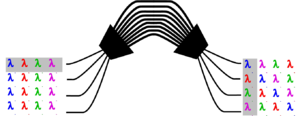Difference between revisions of "Optical Networks"
Cmditradmin (talk | contribs) |
Cmditradmin (talk | contribs) |
||
| Line 95: | Line 95: | ||
Decibels is a log10 scale. | Decibels is a log10 scale. | ||
:<math>Loss(db) = -10 log_{10}\left ( \frac P_{out} P_{in}\right )\,\!</math> | :<math>Loss(db) = -10 log_{10}\left ( \frac {P_{out}} {P_{in}}\right )\,\!</math> | ||
It is easy to remember that 3 db is 50 percent transmission and you can build up the ratios logarithmically from there 6db is 25%, 12 db is 5%. | It is easy to remember that 3 db is 50 percent transmission and you can build up the ratios logarithmically from there 6db is 25%, 12 db is 5%. | ||
Revision as of 14:20, 17 August 2009
| Previous Topic | Return to Organic Photonics Applications Menu | Next Topic |
Introduction to Optical Networks
An optical network can be thought of as rings that are connected together at various distances (1-100s kms)
Optical fiber sets the rules
All optical networking is made possible by the development of optical fibers by AT&T and Corning in the late 1960s. This graph shows attenuation as a function of wavelength. At the most common optical communication wavelength of 1550 nm the attenuation is as low .2 decibels per km. That is only a few percent of loss. Imagine a piece of glass a mile long that is perfectly clear. This was a great achievement for materials science because when they started they were working with losses of decibels per meter. By understanding what led to the loss in fiber they were able to optimize materials and fabrication techniques. The labels across the top indicate important telecommunication wavelengths. 1310 nm was for a long time the most important wavelength because it is the lowest dispersion point where the lease amount of spreading of the light waves happens.
The S, C and L lines in the 1550 nm range is much more important today because it is the range of the erbium doped fiber amplifier (EDFA) which can boost the signal along thousands of kms without having to be turned back into electricity. This is also the range where there is low attenuation.
http://en.wikipedia.org/wiki/Optical_amplifier
Basic optical fiber link
The most elemental optical network requires a transmitter, connected to a receiver with an optical fiber. The transmitter (Tx) can be a directly modulated source such as a laser that is turned on and off. Or it can be an externally modulated (at digital rates up to 40 Gigabits/sec) by passing a constant laser beam through a modulating device. At the end of the fiber link the neat square waves may become spreadout. They are then read by a receiver (Rx) which is a semiconductor detector that operates at high speed and high sensivity (microwatt level). In areas that have local fiber to the home have this very basic configuration over short distances without amplification.
Advanced optical network: dense wavelength division multiplexing A long distance optical network uses dense wavelength division multiplexing. Mux is an optical multiplexer that combines the separate transmitters onto a single optical fiber; demux does the inverse operation.
Transmitters are different wavelengths, narrowly spaced from one another (~ 1 nm) on a standard grid; transmitter can consist of a cw laser + EO modulator
EDFA is an erbium doped fiber optical amplifier that simultaneously amplifies all wavelengths without causing noise or crosstalk. Nature was very kind to provide fiber that is very clear at 1550 nm, however after a 20-30 kms the signal still needs to be regenerated. This could be done by turning the light back into electricity, amplifying this signal and then regenerating the modulated light.
Erbium doped devices have the ability to directly amplify light by 100-1000 times and with simultaneous different wavelengths and without interference. This expands the range of fiber signals to hundreds or thousands of kms.
OADM is an optical add-drop multiplexer is essentially a traffic controller that allows signals to be dropped and added along the way.
The demux is able to separate wavelengths to different receivers. This means that additional bandwidth can be achieved by adding additional wavelengths. This can be done without digging up and replacing fiber which is still the most expensive part of the system.
Passive optical network architecture The passive optical network system is beginning to be deployed in Japan is able to combine. At the central office the OLT – optical line terminal is able to combine various signals such as broadcast TV (1550nm), phone (1490nm) or two way data (1310nm) into a single optical fiber. An optical splitter distributes light from the single fiber into many individual fibers going to each customer premise where is separated into the various electrical signals at the ONU – optical network unit . The OLT can be very expensive because it is centrally located but the ONU must be very inexpensive to make the economics of the system feasible. The bandwidth of fiber is enormous, far higher than coaxial cable or twisted pair phone lines.
There are many application for electro-optics. At the 40Gbps area the demand is rapidly increasing.
Defense:
- Phased-array antennas
- Fiber gyroscopes
- A-to-D converters
Commercial:
- OC-768 (40Gbps) optical networking
- Optical interconnects
- Fiber-to-the-home, CATV
Integration with thin-film optoelectronics
Optical waveguides
A slab type optical waveguide has a core material that has an index of refraction ncore that is higher than the cladding nclad. Light launched into core will propagate by total internal reflection. A channel waveguide has reflection in all directions around the core.
Maxwells wave equation:
You can solve for Beta with a transcendental equation:
B is the propagation constant which determines if light will be propagated in the waveguide
The graph show contours of beta at various thicknesses. The larger the waveguide the more modes that are possible. Multiple modes will spread out due to the differences in the speed of propagation of the waves. Therefore the majority of all long distance optical network (over 1km distance) uses single mode fiber which is very small (<2 mum)
Array waveguide grating (AWG)
The array waveguide is a very successful electro-optical device which works on the principle of interference.
The array waveguide is essentially a multistage, multi cross-connect wavelength coupler. The delay lines between the two sides cause different phase shifts for different wavelength and therefore different wavelengths from one input appear at different outputs.
By coupling each input to all outputs and controlling the characteristics of the coupling, a wavelength at any input can be coupled to a selected outputs. This structure is also known as an MxN multiplexer (or demultiplexer is used in the opposite direction).
Other names found in the literature: Phase array, phaser, Dragone router.
Decibels
Decibels is a log10 scale.
- <math>Loss(db) = -10 log_{10}\left ( \frac {P_{out}} {P_{in}}\right )\,\!</math>
It is easy to remember that 3 db is 50 percent transmission and you can build up the ratios logarithmically from there 6db is 25%, 12 db is 5%.
| Previous Topic | Return to Organic Photonics Applications Menu | Next Topic |




